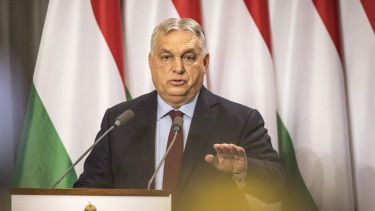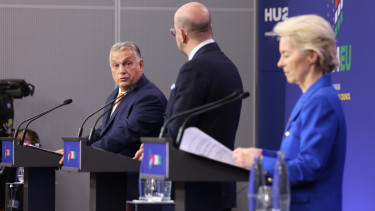Hungary earns top spot in sombre European ranking

In 2020, a cancer diagnosis was made roughly every 12 seconds in the EU, according to a post on the OECD's official Facebook page. The post also shared a Eurostat ranking based on 2019 data, showing cancer deaths per 100,000 people in 2019.
Estimated cancer incidence and mortality rates in Hungary were above the EU averages in 2019-2020.

With 328 deaths per 100 000 population, Hungary registered the highest cancer mortality rate in the EU in 2019.
The current National Cancer Plan aims to reduce cancer mortality by 10% by 2030.
The National Cancer Plan’s priorities include continuation of efforts against behavioural risk factors and expansion of early detection activities.
It also emphasises the need to move towards organ-specific centralisation and to modernise cancer diagnostics and treatment. The latter element includes additional funding for molecular pathology and for refurbishment of radiotherapy equipment.
Steps towards wider application of (targeted) immunotherapy and more modern solutions in oncology surgery are also detailed.
The Plan describes specific objectives, actions and measures for general psycho-oncological support and stresses the need to leverage telemedicine and other digital solutions in cancer care.

Differences in mortality by sex and education were significant. In 2013, men (488 per 100 000) were much more likely to die of cancer than women (269 per 100 000). Among people aged 25-65 years, women with lower education levels were more than twice as likely, and men with lower education levels were four times as likely to die of neoplasms as their counterparts with higher education levels (220 compared to 85 per 100 000 women and 424 compared to 91 per 100 000 men). Differences by educational attainment persisted in older age groups, albeit at lower levels.

Risk factors
Overweight, obesity and smoking rates are important risk factors for cancer in Hungary. Prevalence of smoking has, however, decreased substantially over the past decade, especially among men. A series of government policies may have contributed to this.

Hungary performs relatively poorly on smoking, alcohol consumption, overweight, obesity and exposure to air pollution compared to other EU countries, while the country performs relatively better on HPV vaccination.
In 2019 in Hungary, poor diet (contributing to 24% of deaths vs. an EU average of 17%) and tobacco consumption (contributing to 21% of deaths vs. an EU average of 17%) played key roles in mortality according to the Institute for Health Metrics and Evaluation.
Similarly, 7% of Hungarian mortality was attributable to both alcohol consumption (vs. an EU average of 6%), while the impact of low physical activity on mortality was on a par with the EU average (2%).
In 2020, an estimated 17 new cancer cases per 100 000 population were attributable to alcohol consumption in Hungary, according to IARC. This is among the highest levels in the EU – second only to neighbouring Slovakia.
Recent policies addressing the two most prevalent risk factors have been implemented. In 2020, 3.7% of total health expenditure was dedicated to prevention – a share that exceeds the EU average of 3.4%.
Obesity and overweight are growing problems, especially among people with lower education levels, the oecd warns.
Obesity and overweight are increasingly prevalent health problems in Hungary. More than half of Hungarians (60%) were either obese or overweight in 2019, compared with the EU average of 53%. This represents an 11% increase since 2014.
Obesity and overweight are most prevalent among men and older people: 67% of Hungarian men and 73% of older Hungarians are affected. The proportion of Hungarians with lower education levels experienced the most striking rise in rates of obesity and overweight, with an increase of 23%.
Smoking habits changing
In 2014, Hungarians were among the heaviest smokers in the EU, with one in four reportedly smoking daily.
The situation had improved by 2019, with about one in five Hungarian reporting daily smoking habits, although the percentage of daily smokers (19%) was still slightly above the EU average of 18%. The reduction in 2014-2019 was largely driven by men changing their smoking habits: the proportion of men smoking daily in 2014 was 32%, while in 2019 it was 21%. This trend also reduced the marked gender gap in smoking habits.
25 % of Hungarians with lower education levels were daily smokers in 2019, almost three times as many as those with higher education levels (9 %). This is the largest recorded education gap in smoking reported in the EU.
A series of government measures have contributed to the overall reduction in the proportion of daily smokers, including the restriction of tobacco retail sales to so-called 'national tobacco stores', banning smoking in public spaces, warning labels on packets, and higher excise duties.
Yet, the OECD warns that
use of novel nicotine and tobacco products is on the rise, especially among teenagers.
The share of people aged 13-15 years who had consumed vaping products in the last 30 days rose from 9% in 2013 to 12 % in 2020.
This may be explained in part by the fact that these products are not yet covered by the same tax regime and regulations as traditional tobacco products, although recent regulations have aimed to restrain the distribution of e-cigarettes containing nicotine.
Prevention policies
Hungarian participation rates in early detection activities are on par with the EU average for breast cancer, slightly above EU rates for cervical cancer and almost half of the EU average for colorectal cancer. Large differences in participation in screening services by income levels were seen in Hungary breast and cervical cancers screening.

To facilitate use of early detection services, the Hungarian government instituted nationwide population-based screening programmes (screening offered to a specific at-risk target population) for three types of cancers.
The breast cancer screening programme, initiated in 2001, targets women aged 45-65 years. The programme for cervical cancer started in 2003 and targets women aged 25-65 years. In 2018, in line with the new National Cancer Plan (see above), a screening programme was introduced for colorectal cancer among those aged 50-70 years.
The programmes are fully covered by compulsory health insurance.
In 2019, 60% of Hungarian women aged 50 to 69 years reported having had breast cancer screening within the recommended two years before the survey, lower than the EU average (66%). National estimates show that more than half (62%) of women targeted by the national screening programme (45-65 years) had been screened.
In 2019, Hungary reached an overall cervical cancer screening participation rate of 63%, exceeding the EU average (60%). This was the result of a reduction in the EU average from 61% and a slight increase in Hungary (from 59%) since 2014. Again, breaking down overall participation rate by education levels reveals the most marked inequalities.
In 2019, survey data reported a participation rate of 15 % in colorectal cancer screening activities in the preceding two years among the population aged 50 to 74 years, which is significantly lower than the EU average (33 %). This pronounced disparity is consistent through age, sex, education and income.
Cancer care performance
As in other EU countries, the rate of years of life lost per 100 000 population aged up to 75 years old due to cancer has been decreasing in Hungary since 2000, suggesting improvements in cancer care performance.
However, a shortage of cancer care specialists persists at the regional and national levels, and density of radiation therapy equipment is low, which contributes to geographical disparities in access to care.
Only the National Institute of Oncology has enough oncologists with the necessary qualifications, radiotherapists, radiologists and resident doctors. Additionally, perceived reductions in motivation amongcancer care professionals further exacerbate the challenges created by this shortage. Overall, Hungary reported lower radiation therapy equipment (0.7 per 1 000 cancer cases vs. an EU average of 1.2) and lower physician density than other EU countries (547 per 1 000 cancer cases vs. an EU average of 691).
In 2018, Hungary spent EUR 226 per capita on cancer care, which is 69 % of the EU average (EUR 326).

Cancer incidence in Hungary is among the highest in the EU
According to European Cancer Information System (ECIS) of the Joint Research Centre based on incidence trends from pre-pandemic years, around 62 000 new cancer cases were expected in Hungary in 2020) – approximately 623 per 100 000 people. This exceeds the EU average (569 per 100 000) by 10%.
Cancer incidence rates in Hungary were above EU averages among both men and women in 2020. The age-standardised rate (all cancer) was 761 per 100 000 people among men, in contrast with 686 in the EU, and 540 per 100 000 people among women, in contrast with 484 in the EU.
With around 102 lung cancer cases expected for every 100 000 hungarians, the country had the highest incidence in the EU.
Other leading cancer diagnoses included breast (134 cases per 100 000 population) and colorectal cancer (98 cases per 100 000). Gastric (stomach) cancer was expected to constitute 3 % of new cancer cases in men and 2 % in women in 2020, and skin melanoma was expected to constitute 2 % of new cancer cases in both men and women.
Years of life lost
The years of life lost (YLL) due to cancer shows a decreasing trend in Hungary since 2000, as in other EU countries. However, in 2017, the YLL rate in Hungary (2 235 per 100 000 population aged up to 75 years) was nearly two times higher than the EU average (1 139 per 100 000).
YLL rates for lung and colorectal cancers were more than double the EU averages, which cannot be explained simply by differences in incidence. Explanatory factors may include onset at an earlier age, diagnosis at later stages, less effective treatment or differences in data collection and registration compared to other countries.

Cost of cancer
The total cost of cancer in Hungary in 2018 was estimated to be EUR 1 372 million. The cost per capita (adjusted for differences in purchasing power) was EUR 226, which is 69% of the EU average (EUR 326).
Nearly half of the total sum (EUR 618 million) was expenditure on cancer care, and spending on cancer drugs was almost two thirds of that total – a proportion twice the EU average.
Alongside direct expenditure on cancer care, the total cost includes informal costs and indirect costs (productivity loss). While the former is on a par with the EU average, productivity loss due to premature mortality significantly exceeds it.

Click here for the OECD's full report on Hungary.
Cover photo: Getty Images








